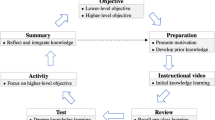Abstract
It is necessary to embed formative assessment within a broader theoretical field to understand it fully as it should be understood in the context of pedagogy. Business education with incentive systems intrigues the new pedagogical concept of a flipped approach divided into distinct levels drawing on Bloom's taxonomy. Bloom’s taxonomy plays a significant role in influencing instructional delivery, curriculum planning, and assessment. It allows the instructors to set educational goals and develop evaluation tools based on a more accurate classification of knowledge levels. Students’ learning and critical thinking are measured through assessments within the six taxonomy levels, which can challenge educators. Despite the need for careful planning, developing Bloom's taxonomy assessments can be a straightforward process. This research exemplifies how formative assessment can be employed in flipped classroom learning by deliberating Bloom's taxonomy into the classroom's instructional delivery and assessment. Additionally, it extends theories and practices on how formative assessment has recently been discussed and explored as a learning tool in business education and assessment areas.
Access this chapter
Tax calculation will be finalised at checkout
Purchases are for personal use only
Similar content being viewed by others
References
Earl, L.M.: Assessment as Learning: Using Classroom Assessment to Maximize Student Learning. Corwin Press, Thousand Oaks (2012)
Perrenoud, P.: Assessment in Education (1998)
Black, P., Wiliam, D.: Classroom assessment and pedagogy. Assess. Educ.: Principles Policy Pract. 25, 551–575 (2018). https://doi.org/10.1080/0969594X.2018.1441807
Beetham, H., Sharpe, R.: Rethinking pedagogy for a digital age designing for 21st century learning (2013). https://doi.org/10.4324/9780203078952
O’Flaherty, J., Phillips, C.: The use of flipped classrooms in higher education: a scoping review. Internet High. Educ. 25, 85–95 (2015). https://doi.org/10.1016/j.iheduc.2015.02.002
Huang, C.K., Lin, C.Y.: Flipping business education: transformative use of team-based learning in human resource management classrooms. Educ. Technol. Soc. 20(1), 323–336 (2017)
Prashar, A.: Assessing the flipped classroom in operations management: a pilot study. J. Educ. Bus. 90, 126–138 (2015). https://doi.org/10.1080/08832323.2015.1007904
Bloom, B.S.: Taxonomy of Educational Objectives: The classification of Educational Goals. Cognitive domain, New York (1956)
Anderson, L.W., Krathwohl, D.R.: A taxonomy for learning, teaching, and assessing: a revision of Bloom’s taxonomy of educational objectives. Longman, (2001)
Eber, P.A., Parker, T.S.: Assessing student learning: applying bloom’s taxonomy bloom’s taxonomy. Human Serv. Educ. 27(1), 45–53 (2007)
Knight, P.: The local practices of assessment. Assess. Eval. High. Educ. 31, 435–452 (2006)
Sadler, D.R.: Formative assessment and the design of instructional systems. Instr. Sci. 18(2), 119–144 (1989). https://doi.org/10.1007/BF00117714
Weurlander, M., Söderberg, M., Scheja, M., Hult, H., Wernerson, A.: Exploring formative assessment as a tool for learning: students’ experiences of different methods of formative assessment. Assess. Eval. High. Educ. 37, 747–760 (2012). https://doi.org/10.1080/02602938.2011.572153
Shepard, L.A.: Linking formative assessment to scaffolding. Educ. Leadersh. 63, 66–70 (2005)
Gan, Z., Leung, C.: Illustrating formative assessment in task-based language teaching. ELT J. 74, 10–19 (2020). https://doi.org/10.1093/ELT/CCZ048
Pryor, J., Crossouard, B.: A socio-cultural theorisation of formative assessment. Oxf. Rev. Educ. 34, 1–20 (2008). https://doi.org/10.1080/03054980701476386
McCallum, S., Milner, M.M.: The effectiveness of formative assessment: student views and staff reflections. Assess. Eval. High. Educ. 46, 1–16 (2021). https://doi.org/10.1080/02602938.2020.1754761
Sailer, M., Sailer, M.: Gamification of in-class activities in flipped classroom lectures. Br. J. Edu. Technol. 52, 75–90 (2021). https://doi.org/10.1111/bjet.12948
Lin, C.-L., et al.: The influence of affective feedback adaptive learning system on learning engagement and self-directed learning (2022). https://doi.org/10.3389/fpsyg.2022.858411
Roehl, A., Reddy, S.L., Shannon, G.J.: The flipped classroom: an opportunity to engage millennial students through active learning strategies. J. Fam. Consum. Sci. 105(2), 44–49 (2013)
Huang, Y.M., Silitonga, L.M., Wu, T.T.: Applying a business simulation game in a flipped classroom to enhance engagement, learning achievement, and higher-order thinking skills. Comput. Educ. 183, 104494 (2022). https://doi.org/10.1016/j.compedu.2022.104494
Galway, L.P., Corbett, K.K., Takaro, T.K., Tairyan, K., Frank, E.: A novel integration of online and flipped classroom instructional models in public health higher education. BMC Med. Educ. (2014). https://doi.org/10.1186/1472-6920-14-181
Kuo, Y.-C., Lin, Y.-H., Wang, T.-H., Lin, H.-C.K., Chen, J.-I., Huang, Y.-M.: Student learning effect using flipped classroom with WPSA learning mode-an example of programming design course. Innovations Educ. Teac. Int. 1–12 (2022)
Chyung, S.-Y., Stepich, D.: Applying the" congruence" principle of Bloom’s taxonomy to designing online instruction. Q. Rev. Distance Educ. 4, 317–330 (2003)
Morton, D.A., Colbert-Getz, J.M.: Measuring the impact of the flipped anatomy classroom: the importance of categorizing an assessment by Bloom’s taxonomy. Anat. Sci. Educ. 10, 170–175 (2017). https://doi.org/10.1002/ase.1635
Almasseri, M., AlHojailan, M.I.: How flipped learning based on the cognitive theory of multimedia learning affects students’ academic achievements. J. Comput. Assist. Learn. (2019). https://doi.org/10.1111/jcal.12386
Krathwohl, D.R.: A revision of Bloom’s taxonomy: an overview. Autumn (2002)
Acknowledgements
This research is partially supported by the Ministry of Science and Technology, Taiwan, R.O.C. under Grant No. MOST 108–2628-H-224–001-MY3, MOST 110–2511-H-224–003-MY3 and MOST 110–2622-H-224–001-CC2.
Author information
Authors and Affiliations
Corresponding author
Editor information
Editors and Affiliations
Rights and permissions
Copyright information
© 2022 The Author(s), under exclusive license to Springer Nature Switzerland AG
About this paper
Cite this paper
Sari, N.A.R.M., Winarto, Wu, TT. (2022). Exemplifying Formative Assessment in Flipped Classroom Learning: The Notion of Bloom's Taxonomy. In: Huang, YM., Cheng, SC., Barroso, J., Sandnes, F.E. (eds) Innovative Technologies and Learning. ICITL 2022. Lecture Notes in Computer Science, vol 13449. Springer, Cham. https://doi.org/10.1007/978-3-031-15273-3_43
Download citation
DOI: https://doi.org/10.1007/978-3-031-15273-3_43
Published:
Publisher Name: Springer, Cham
Print ISBN: 978-3-031-15272-6
Online ISBN: 978-3-031-15273-3
eBook Packages: Computer ScienceComputer Science (R0)




